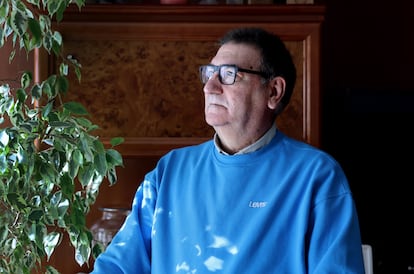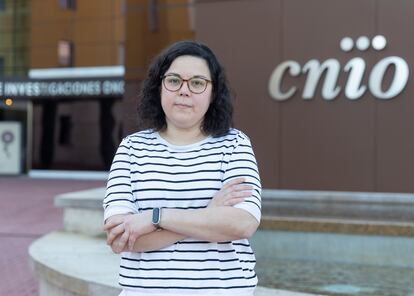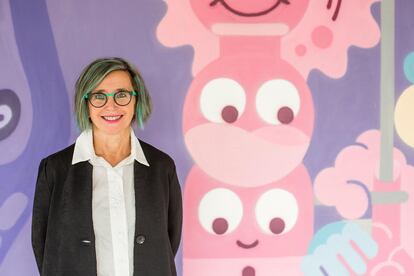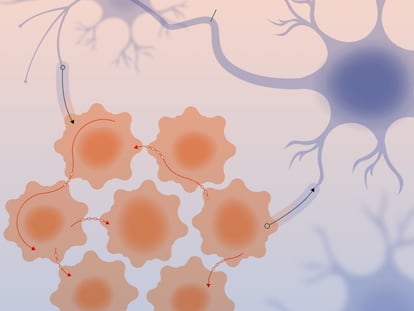A million-dollar project against familial cancer aims to take thousands of people out of the ‘genetic purgatory’
The research, involving nine Spanish centers, seeks to identify mutations that cause a higher-than-usual incidence of cancer in about 300 families

“‘Fear’ is not the word I’d use to describe my feelings,” says Carlos Róspide, “but there is an anxiety. You’re always on the watch for something. You hope it doesn’t happen, but you know it can.” At the age of 60, two months before retiring, Róspide was diagnosed with breast cancer. That was the first in a list of bad news. Shortly afterward, he was diagnosed with kidney cancer. Then, prostate. Meanwhile, three of his five siblings were facing similar situations: one of his brothers was treated for a tumor in his appendix, another developed prostate cancer and his sister was found to have breast cancer.
The pattern clearly responded to that of a familial cancer, but genetic testing was inconclusive. Only a minimally suspicious variant was detected in the DNA of one of the genes studied, which was classified at the time as “of uncertain significance,” although it has practically been ruled out as the cause. The situation puts them, like many other families in these circumstances, in a limbo of knowledge and information. They know that something abnormal is happening, but not what alteration causes it or who carries it in their DNA.
Now, a project in which nine Spanish research centers are involved, funded with more than $3 million by the Precision Medicine Infrastructure of the Carlos III Health Institute, is looking for the cause in approximately 300 families in this situation. To do this, they will not only study the most common genes, but the entire DNA, using computer tools to sift through the abundance of information and conducting specific laboratory experiments for each alteration. Carlos Róspide’s is among those 300 families.
“The Spanish National Health System offers a genetic diagnosis to families who clearly have a hereditary cancer pattern, but many remain unresolved,” explains Mercedes Robledo, head of the Hereditary Endocrine Cancer Group of the Spanish National Cancer Research Center (CNIO), which is participating in the project, named IMPaCT-VUScan, with four groups. “Now we want to go far beyond the diagnostic routine to help some of them, but also to develop tools that help the doctor’s decision making in the future,” says Robledo.
A familial component
“Between 10% and 15% of tumors have a familial or inherited component,” explains María Currás, head of the Familial Cancer Clinical Unit at the CNIO, who in addition to participating in the project is in charge of the Róspide family. This component may be suspected when more cases than usual accumulate within the same family, if tumors develop in different organs, or if they appear at a very early age. Although adapted care and follow-up can reduce mortality, in many cases the cause is not known with certainty.
In the case of breast cancer, for example, “known predisposition genes only explain between 30% and 40% of cases with hereditary influence,” says Currás. Suspicion does not necessarily imply a family pattern, but “overall, if all suspected cases are taken into account, in more than 80% of cases the responsible mutation is not found,” acknowledges Conxi Lázaro, head of the Hereditary Cancer Research Group at the Catalan Institute of Oncology-IDIBELL and leader of the IMPaCT-VUScan project.
Moreover, variants of uncertain significance are increasingly common in tests, DNA changes for which there is insufficient information to determine if they are responsible for the risk. This is precisely what happened in the initial diagnosis of the Róspide family, with the added predisposition that the specific variant was present in four siblings, all of whom had developed some tumor, while the only one who had not suffered from any tumor did not inherit this variant.

Although the vast majority of these uncertain variants are ultimately benign (the change they produce is harmless), they represent “a nightmare for geneticists,” explains Robledo. The rule is that no clinical decision should be made based on their presence. However, they do increase the uncertainty; it has been said that, more than limbo, they put the carrier in a “genetic purgatory.” Currás stresses the importance of the way these results are communicated; although the reactions vary, she says, people usually take it as something negative. “They sense that something strange has been found in them, something they don’t know what to tell them about, and in the end they feel the same or worse than before.”
The appearance of this type of changes is rising, as the extent of testing and the genetic data received increases. It is a paradox: the more data is gathered, the more likely they are to obtain an answer, but also the more likely it is that uncertainties will appear. That will also happen with the IMPaCT-VUScan project. By sequencing the entire genome, “lots of variants of uncertain significance will appear,” Lázaro explains. But unlike what happens in clinical routine, here they will be prioritized and studied in depth, seeking to reach a conclusion. “I volunteered to seek knowledge and to help tackle the problem of familial cancer and improve survival,” explains Róspide. “Even if it’s a slow process,” he adds almost instantly.
Aiming for equity
The vast majority of the changes that they will find in the DNA of families will be harmless and, to some extent, common. In order to filter and prioritize through all the noise, they designed bioinformatics tools that factor in how these variants in the genes affect the proteins they give rise to, how their shape changes in space, their position in the dense cellular network, or how evolution has preserved them. With all this, they will select specific candidates in each family and carry out “absolutely individualized experiments for each variant, which will allow us to know if they really have an effect,” explains Robledo.

The information obtained “will return to the bioinformatics tools to feed real data to the artificial intelligence and what the prediction had told us,” continues the researcher, with the ambitious but complex goal that, in the future, it will help make decisions directly in the doctor’s office. Because these experiments are not only usually unavailable in clinical routine; in addition, “they can take years, and even be unsuccessful,” says Robledo, for whom this project is “quite unique and pioneering due to the level of resources, tools and studies planned.”
The value of information
Róspide admits that a situation like his “completely changes the structure of life. When you’re healthy — or you think you are — life goes by without paying much attention to time. With something like this, your perspective changes. It becomes more short-term. The distance of worries becomes shorter: the next visit. The next test. I find it amusing when they say in the news that someone has beat cancer. You beat cancer when they stop testing you.” Although no mutation has been found to explain the Rospide family’s cases of cancer, all siblings must follow a schedule of visits and medical examinations tailored to their situation, a much more exhaustive series of measures than usually recommended.
Clinical trials exist for some preventive therapies against familial cancer, but there is none officially approved as such (excluding preventive surgery for certain cases of breast cancer predisposition). There are also some specific drugs to treat tumors with mutations in the BRCA1 and 2 genes (the most common in familial breast cancer) or for patients with colon cancer and changes that make them more sensitive to immunotherapy; however, the mutation does not usually dictate the treatment. “Identifying new responsible variants could serve to use or develop new drugs, even for people where these changes take place in an isolated, non-familial way,” explains Lázaro, “but it will be difficult, among other things because the proportion of patients for each of them It will be small.”
What can be the use, then, of finding the responsible mutation? On one hand, to rule out an increased risk in those family members in whom it is not present, relieving their anxiety. This also includes sons and daughters, a primary concern in these situations, in addition to the possibility of offering genetic counseling if they decide to procreate. On the other hand, to personalize the care and diagnoses. This is what allowed, for instance, to do a multi-year investigation carried out by Robledo’s group in three families with a high risk of pheochromocytoma, a rare tumor of the adrenal glands. They found that in those three cases the cause was in a gene that had never been linked to the disease before, shared the information with an international consortium and located other families with the same mutations. That led them to infer that “they had a specific clinical profile,” explains Robledo. “They had a higher risk of metastases, so closer monitoring was advisable, and these tended to appear in certain places, so now we know where to look.”
Faced with the limbo in which they find themselves, “the information gives these families an answer to one of their questions: why me?” highlights Lázaro. “In addition, it is a tool that allows them to empower themselves in the face of many vital decisions and adapt the care they receive, which after all is what we mean when we talk about personalized medicine. It gives them the power to control some aspects of their life.” “I’m not interested in being the center of attention,” reflects Róspide. “If I tell my story, it’s because I think it can help.”
Sign up for our weekly newsletter to get more English-language news coverage from EL PAÍS USA Edition
Tu suscripción se está usando en otro dispositivo
¿Quieres añadir otro usuario a tu suscripción?
Si continúas leyendo en este dispositivo, no se podrá leer en el otro.
FlechaTu suscripción se está usando en otro dispositivo y solo puedes acceder a EL PAÍS desde un dispositivo a la vez.
Si quieres compartir tu cuenta, cambia tu suscripción a la modalidad Premium, así podrás añadir otro usuario. Cada uno accederá con su propia cuenta de email, lo que os permitirá personalizar vuestra experiencia en EL PAÍS.
¿Tienes una suscripción de empresa? Accede aquí para contratar más cuentas.
En el caso de no saber quién está usando tu cuenta, te recomendamos cambiar tu contraseña aquí.
Si decides continuar compartiendo tu cuenta, este mensaje se mostrará en tu dispositivo y en el de la otra persona que está usando tu cuenta de forma indefinida, afectando a tu experiencia de lectura. Puedes consultar aquí los términos y condiciones de la suscripción digital.
More information
Archived In
Últimas noticias
Welcome to the post-religion era: The idea of Christianity as the absolute truth has become obsolete
‘I thought you would like it’: The risky sexual practice popularized by TV shows and TikTok
The digitalization of tourism: ‘They promise experiences and gave us the worst possible one’
Mexican peso defies uncertainty with forecasts of a new period of stability in 2026
Most viewed
- Sinaloa Cartel war is taking its toll on Los Chapitos
- Reinhard Genzel, Nobel laureate in physics: ‘One-minute videos will never give you the truth’
- Oona Chaplin: ‘I told James Cameron that I was living in a treehouse and starting a permaculture project with a friend’
- Why the price of coffee has skyrocketed: from Brazilian plantations to specialty coffee houses
- Silver prices are going crazy: This is what’s fueling the rally










































